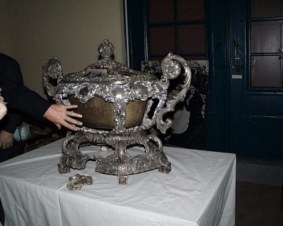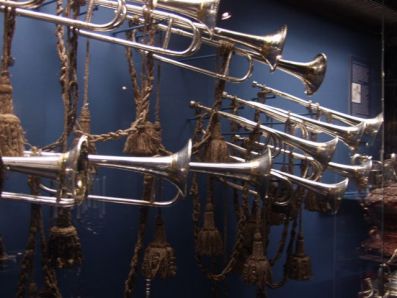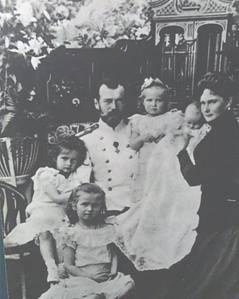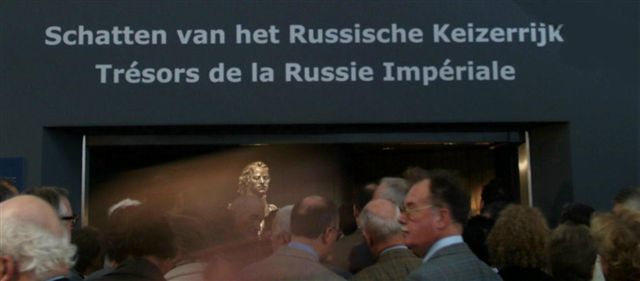The hall of Imperial Russian Silverware of the Musée Royal de
l'Armée et d'Histoire Militaire of Bruxelles
(part 1)
The Musée Royal de l'Armée et d'Histoire Militaire of
Bruxelles (Royal Museum of the Army and of Military history), Belgium,
has a hall devoted to Russian silverware from the age of the last Tsars,
Alexander III and Nicholas II.
It is unusual that a museum devoted to the ancient military history of
Belgium, the fights of WWI and WWII, the Napoleonic era, the weapon
systems, the ancient armours, the Air Force, the Navy, the tanks, etc…
had a hall devoted to masterpieces of Russian silverware.
The Musée Royal de l'Armée of Bruxelles is among the grander
museums of the world. It is hosted in a prestigious setting and is the
most visited Belgian museum.
A complete visit requires several days and its library, frequented every
year by thousands of researchers, has a wide endowment of works and very
rare archives.
The history of the Cossacks is strictly linked to Russian Emperors, as
they were elite regiments appointed to the guard of the Sovereigns and
of their families. The Imperial Guard Regiment was created by Catherine
II in April 1775.
In the famous battle of Leipzig, in September 1813, the Cossacks
sacrificed waiting the arrival of the allied troops while the King of
Prussia, the Austrian Emperor and the Tsar Alexander I were encircled on
an hill by French cuirassiers. The bravery of Russian Cossacks saved the
sovereigns avoiding their capture by Napoleon's army. Without the
Cossacks' heroism the history of Europe would have been modified!
The Cossacks were covered with glory and rewarded with gifts. The silver
objects were displayed in the cabinets of the Guards' Officer's mess of
St. Petersburg together with the gifts offered on other occasions by the
Tsar and with the silver items presented to high ranking officers at the
moment of their retirement and traditionally deposited in the mess'
cabinets.
The Russian civil war of 1917 saw the victory of the Communist troops of
the Red Army against the White Army. The regiments of the Cossacks,
together with the other members of the Russian White Army, after a
fierce struggle, were obliged to leave Russia and emigrate to Europe.
The survivors of the Imperial Guard Regiment arrived in Paris after an
exhausting trip through Europe at war. After settling in Paris, in a
suburban house rented at Courbevoie, their main concern was to recover
the Regiment's treasure that they had brought from Russia and stored in
Yugoslavia; however, the lack of sufficient financial means meant a long
wait before its retrieval
After the victory of the Front Populaire in the French elections of
1936, the Cossacks worried about the possibility of their treasure being
impounded by the French Communists and its subsequent disposal in the
USSR. Therefore, in 1938, they asked the King of Belgium, Léopold III,
to be allowed to deposit the Regiment's treasure in the Musée de l'Armée
of Bruxelles, a secure location, as Belgium had no link with Russian
communism.
Since this era, this treasure was located in the display cabinets of the
museum, next to weapons, uniforms and equipment of the 1914 Russian
Army, in a manner not appropriate to its value.
Following the awareness of the situation by the association of the Amis
du Musée Royal de l'Armée of Bruxelles (Friends of the Royal Museum of
the Army) and the insistence of the owners of this treasure from Paris,
it was decided to display these pieces in a worthy manner: a special new
ultra-modern hall designed by the Swiss talent (of English origin) Ian
Ashdown along with the firm Meyvaert of Gent, the foremost Belgian
specialist in display and lighting.
The hall was inaugurated on October 2, 2001 by the Belgian minister of
Defense, the Ambassador of the Russian Federation, the Cultural Attaché
and an audience of civil and military personalities. The hall is bathed
in obscurity in order to emphasize the exposed pieces: rare military
uniforms (and furthermore those of three Emperors and the Tsarevitch),
banners and flags of regiments, portable weapons, military hats,
decorations and awards and, of course, the silverware.
 The
most important silver piece is the punch bowl in Rocaille style,
weighing over 110 pounds, decorated with porcelain medallions
representing the battle of Leipzig and the portraits of the Tsars
since the creation of the Guard Cossack Regiment. This unique
artwork of inestimable value has a gilt interior and was a gift of
the Nobility Society of the Don Region to the Guard Cossack
Regiment. The
most important silver piece is the punch bowl in Rocaille style,
weighing over 110 pounds, decorated with porcelain medallions
representing the battle of Leipzig and the portraits of the Tsars
since the creation of the Guard Cossack Regiment. This unique
artwork of inestimable value has a gilt interior and was a gift of
the Nobility Society of the Don Region to the Guard Cossack
Regiment. |
 Other
important pieces are the 22 different trumpets made by the musical
instruments manufacturer Romo, using parcel-gilt silver to the
standard of 84 zolotniks (875/1000 silver). The sonorous timbre of
the silver trumpets is outstanding, particularly when the Band of
the Guard Cossack Regiment plays Mendelssohn's Wedding March, which
is the Regiment's March. Other
important pieces are the 22 different trumpets made by the musical
instruments manufacturer Romo, using parcel-gilt silver to the
standard of 84 zolotniks (875/1000 silver). The sonorous timbre of
the silver trumpets is outstanding, particularly when the Band of
the Guard Cossack Regiment plays Mendelssohn's Wedding March, which
is the Regiment's March. |
Visitors are delighted in front of the big kovsh unbelievably
decorated in the workshop of the imperial silversmith Ovchinnikov, or
the bowl made by Fabergé, or the dishes and saucers, the candlesticks,
the huge fruit bowls, the pendulum clock, the inkstand, the ladles in
Art Nouveau style, the vodka beakers in the shape of miniature
helmets of Lanciers and many other objects chiseled, engraved, nielloed
and enamelled using champlevé and cloisonné techniques by
workshops of imperial silversmiths. There are more than 200 high value
pieces. An exhibition of great interest for anybody who appreciates the
beautiful Russian silverware of the 19th century.
Claude-Charles Feÿs
Administrator of SRAMA
Silverware's Amateur - Expert
Member of Groupe de Travail Salle Russe
Société Royale des Amis du Musée Royal
de l'Armée et d'Histoire Militaire, Bruxelles
(Work Group Russian Hall)
The Musée Royal de l'Armée et d'Histoire Militaire of Bruxelles
is situated 3, Parc du Cinquantenaire, 1000 Bruxelles BELGIUM
Open everyday except on Monday.
Free entry. Guide on request. Tel: 00-32-27377811
Société Royale des Amis du Musée Royal de l'Armée et d'Histoire
Militaire (SRAMA).
Tel: 00-32-27377890 Fax: 00-32-27377892 e-mail:
srama@euronet.be

The Russian Imperial family
The Tsar Nicolas II, the Tsarina Alexandra Fiodorovna (holding the
Tsarevitch in her arms) and the Grand Duchesses
(original photo belonging to the Russian Hall of the Musée Royal de
l'Armée et d'Histoire Militaire of Bruxelles collection)
|
Photos copyright Raoul Verbist
This is the English version from the original French text,
translated by Giorgio Busetto and revised by Douglas Hawkes
|




